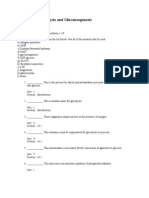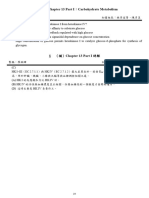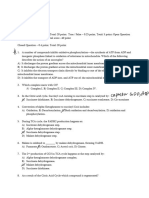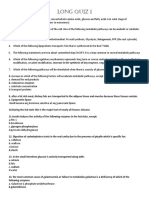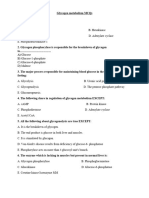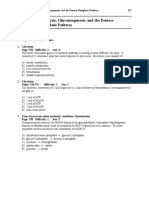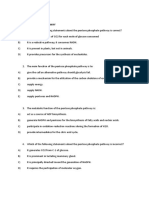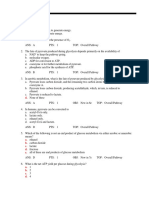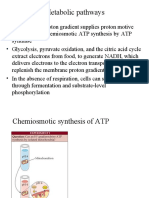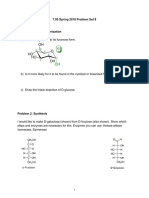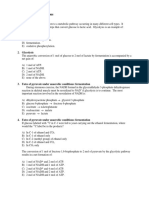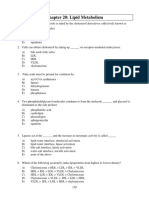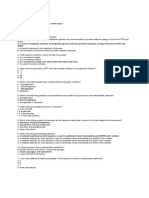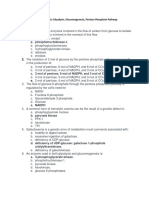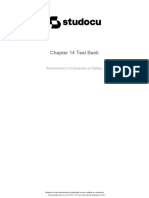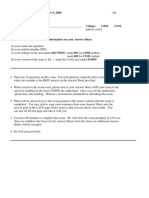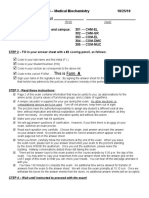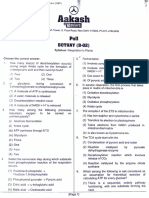chapter 8 (glycolysis) أسئلة السنوات
chapter 8 (glycolysis) أسئلة السنوات
Uploaded by
معاوية محمدCopyright:
Available Formats
chapter 8 (glycolysis) أسئلة السنوات
chapter 8 (glycolysis) أسئلة السنوات
Uploaded by
معاوية محمدCopyright
Available Formats
Share this document
Did you find this document useful?
Is this content inappropriate?
Copyright:
Available Formats
chapter 8 (glycolysis) أسئلة السنوات
chapter 8 (glycolysis) أسئلة السنوات
Uploaded by
معاوية محمدCopyright:
Available Formats
General Biochemistry
Quiz 8 Glycolysis
1) How many H2O molecules are produced by glycolysis?
a) 1 b) 2 c) 3 d) 4
Answer: B, H2O is released when 2-phospoglycerate is converted to phosphoenolpyruvate and this step happens
2 times in glycolysis of 1 glucose molecule.
2) The enzyme that catalyzes the phosphorylation of glucose in glycolysis is:
a) Hexokinase b) Phosphofructokinase 1 c) Glucokinase d)Hexokinase and glucokinase
Answer: D, Tip: any enzyme that ends with “kinase” is a phosphorylation enzyme. Phosphofructokinase
phosphorylates F6P not glucose.
3) GLUT-1 transporter is found in which cells?
a) Leukocytes b) Erythrocytes c) Muscles d) Liver
Answer: B, muscles(and adipose) have GLUT 4(insulin dependent), and liver has GLUT 2.
4) Which of the following can be transported by GLUT-2 in mucosal intestinal cells?
a) Glucose b) Fructose c) Galactose d) All
Answer: D, GLUT 2 transports all types of sugar, GLUT 5 is fructose only, SGLT-1 is for galactose and glucose.
5) Phosphofructokianse-1(PFK-1) is activated by:
a) Fructose1,6-bisphosphate b) AMP c)Citrate d)ATP
Answer: B, PFK-1 is activated by fructose2,6-bisphoshate and AMP.
6) Which of the following stimulates pyruvate kinase?
a) Glucagon b) Glucocorticoids c) Fructose 2,6- bisphosphate d) Fructose 1,6- bisphosphate
Answer: D, pyruvate kinase is stimulated by Fructose 1,6-bisphosphate and insulin.
BRIEF team Page 1
General Biochemistry
7) Glycolysis takes place in which part of the cell?
a) Mitochondrial Matrix b) Intermembrane space c) Nucleus d) Cytosol
Answer: D
8) The enzyme involved in converting glyceraldehyde 3-phosphate to 1,3-BPG is:
a) glyceraldehyde 3-phospahte carboxylase
b) glyceraldehyde 3-phosphate dehydrogenase
c) phosphoglycerate kinase
d) phosphoglycerate mutase
Answer: B
9) The rate limiting step of glycolysis is(IMPORTANT)
a) Hexokinase
b) PFK-1
c) Pyruvate Kinase
d) PFK-2
Answer: B
10) Glucose 6-phosphatase is found in?
a) Hepatocytes(Liver)
b) Erythrocytes
c) Alpha cells of pancreas
d) Beta cells of pancreas
Answer: A, this enzyme produces glucose for the blood, and the liver produces glucose so it’s found in liver.
11) How many NADH will be produced by anaerobic glycolysis?
a) 4 b) 2 c) 1 d) 0
Answer: B, one glucose molecule produces 2 NADH during glycolysis.
12) Which of the following is NOT true about Glucokinase?
a) activated by translocation to nucleus
b) the sugar specificity of the enzyme is similar to that of other hexokinases.
c) predominate in B cells of pancreas
d) has higher Km and Vmax than other hexokinases
Answer: A, GK is activated when it’s out of the nucleus, other choices are true.
BRIEF team Page 2
General Biochemistry
13) cAMP hydrolysis to 5’AMP(AMP) is carried out by:
a) G-protein
b) cAMP Phosphodiesterase
c) cAMP Adenylyl cyclase
d) cAMP UCPs
e) Protein kinase A
Answer: B, adenylyl cyclase transforms ATP to cAMP, phosphodiesterase transforms cAMP to AMP.
14) The products of the pathway from glucose to lactate are:
a) 0 ATP 2 Lactate
b) 1 ATP 1 Lactate
c) 0 ATP 1 Lactate
d) 2 ATP 2 Lactate
Answer: D, 2 ATP from glycolysis and 2 lactate from each pyruvate molecule.
15) Hexokinase has higher affinity to glucose because of higher Km.
a) True b) False
Answer: False, higher Km = less affinity.
16) PFK-1 deactivated/inhibited by:
a) AMP b) Fructose 2,6- bisphosphate c) ATP d) A+B
Answer: C, PFK-1 is deactivated by ATP and citrate, and activated by AMP and Fructose 2,6- bisphosphate.
17) In the formation of PEP(phospoenolpyruvate), which of the following occurs?
a) production of H2O
b) consumption of H2O
c) NAD+ TO NADH
d) Production of ADP
e) Production of ATP
Answer: A
BRIEF team Page 3
General Biochemistry
18) Phosphoglucose isomerase enzyme forms:
a) Fructose-6-P or Glucose-6-P
b) NADH
c) Glucose 6 P
d) Fructose 6 P
e) ADP
Answer: A, this enzyme catalyzes reversible reaction between F6P and G6P
19) Which of the following molecules is the substrate for the aldolase enzyme?
a) Pyruvate
b) Aldose hexose sugars
c) Oxaloacetate
d) Phosphoenol pyruvate
e) Fructose 1,6- Bisphosphate
Answer: E
20) Which of the following enzymes in the glycolysis pathway does NOT involve ATP?
a) Glyceraldehyde-3-p-dehydrogenase
b) Pyruvate kinase
c) Phosphoglycerate kinase
d) Glucokinase
e) Hexokinase
Answer: A, Tip: all other enzymes are “kinases” which adds pho sphate to a molecule so they require ATP.
BRIEF team Page 4
You might also like
- Nutritional Healing, After The - Kathryn Alexander PDFDocument430 pagesNutritional Healing, After The - Kathryn Alexander PDFPriscilla Ferreira Crespo Gutierrez100% (4)
- 6 - Biochemistry MCQs Carbohydrates MetabolismDocument17 pages6 - Biochemistry MCQs Carbohydrates Metabolismwanna learn100% (2)
- Chapter 16 Test BankDocument7 pagesChapter 16 Test BankDilla Wulan NingrumNo ratings yet
- BRS Biochemistry (Questions)Document21 pagesBRS Biochemistry (Questions)unknownxem100% (3)
- Biochem HomeworkDocument13 pagesBiochem Homeworkfcukingfranztastik50% (2)
- Quiz GlycolysisDocument23 pagesQuiz Glycolysisali.raza.dar.1No ratings yet
- 003 F Eng FromChem 04-06 Questions AnnaDocument40 pages003 F Eng FromChem 04-06 Questions AnnaHossam HMNo ratings yet
- 6 TH Formative AnswerDocument6 pages6 TH Formative AnswerGiug 7f7fNo ratings yet
- BiochemcomquizDocument43 pagesBiochemcomquizaikaNo ratings yet
- Carbohydrate Metabolism - MCQ On Glycolysis & GluconeogenesisDocument13 pagesCarbohydrate Metabolism - MCQ On Glycolysis & Gluconeogenesisolayemi mariamNo ratings yet
- Questions On Carbo 5Document6 pagesQuestions On Carbo 5iamroshdinhoNo ratings yet
- Carbohydrate Metabolism 2024Document18 pagesCarbohydrate Metabolism 2024Dr. 001No ratings yet
- Carbohydrate Q.BDocument7 pagesCarbohydrate Q.Bahmedabdalnaser87No ratings yet
- ch13~15Document9 pagesch13~15r13641028No ratings yet
- OopDocument9 pagesOopakhidenorshekinahNo ratings yet
- Carbohydrate Metabolism-multiple Choice QuestionDocument3 pagesCarbohydrate Metabolism-multiple Choice QuestionSreelakshmi BNo ratings yet
- Secondymcq 12Document5 pagesSecondymcq 12Santosh KathwateNo ratings yet
- بايو بيبر 1 د.جميلة السمهريDocument8 pagesبايو بيبر 1 د.جميلة السمهريOzgan SüleymanNo ratings yet
- 1st Long Quiz - Overview of Metab, Carb Metab 1 and 2Document5 pages1st Long Quiz - Overview of Metab, Carb Metab 1 and 2MineTagraNo ratings yet
- PODII Glycogen Metabolism Q.B NSDocument3 pagesPODII Glycogen Metabolism Q.B NShgffyjfdthcNo ratings yet
- Ch14 Biochem LehningerDocument20 pagesCh14 Biochem LehningerhielNo ratings yet
- Carbohydrate Metabolism SamplexDocument13 pagesCarbohydrate Metabolism SamplexCherie ThompsonNo ratings yet
- GlycolysisDocument5 pagesGlycolysismahesh kumarNo ratings yet
- Biology MCQDocument97 pagesBiology MCQmakayimaselaNo ratings yet
- Tutorial 1Document2 pagesTutorial 1Nadia MaisaraNo ratings yet
- ch10~13-1Document5 pagesch10~13-1r13641028No ratings yet
- TestDocument23 pagesTestParth sarthi Sen guptaNo ratings yet
- Testbank Final-284-322Document39 pagesTestbank Final-284-322khulood almerriNo ratings yet
- DnlodDocument43 pagesDnlod312887No ratings yet
- Metabolism of CarbohydrateDocument23 pagesMetabolism of Carbohydrate99NivrithiNo ratings yet
- Ketone Bodies MCQsDocument19 pagesKetone Bodies MCQsMasoom KassiNo ratings yet
- Silz Recap 2 SolutionsDocument5 pagesSilz Recap 2 SolutionschibuyeNo ratings yet
- Recap Q2Document2 pagesRecap Q2chibuyeNo ratings yet
- Bio LectureDocument38 pagesBio LectureDaniel ZederNo ratings yet
- 2021-DPN-Biochem 2-Exam 1Document8 pages2021-DPN-Biochem 2-Exam 1chienyu2002No ratings yet
- MIT7 - 05S20 - Pset8 BIOCHEMDocument9 pagesMIT7 - 05S20 - Pset8 BIOCHEMRejoice chekesaNo ratings yet
- Multiple Choice Questions: 1. GlycolysisDocument4 pagesMultiple Choice Questions: 1. GlycolysisNguyễn Tân100% (1)
- PPP QuestionsDocument3 pagesPPP QuestionsHarun MohamedNo ratings yet
- Carbohydrate MetabolismDocument6 pagesCarbohydrate Metabolismsara43adamsNo ratings yet
- Bio ExamDocument4 pagesBio Examhagermohamed5235No ratings yet
- Biochemistry MCQsDocument11 pagesBiochemistry MCQshappy9874648No ratings yet
- Biochemistry Midterm Questions - Overdose 12-11-2018: Ans: Aldolase BDocument6 pagesBiochemistry Midterm Questions - Overdose 12-11-2018: Ans: Aldolase BAhmed HamarnehNo ratings yet
- Title of Textbook: Biochemistry, The Molecular Basis of Life, Trudy McKee & James R. McKee Test QuestionsDocument555 pagesTitle of Textbook: Biochemistry, The Molecular Basis of Life, Trudy McKee & James R. McKee Test Questionscp7tvjddyrNo ratings yet
- MCQ ChoDocument31 pagesMCQ Choامجد حسين جواد كاظمNo ratings yet
- Quiz-4-Storage Mechanisms and Control in Carbohydrate MetabolismDocument5 pagesQuiz-4-Storage Mechanisms and Control in Carbohydrate Metabolismaichiii.bearNo ratings yet
- ch20-22 - Probleme SetDocument8 pagesch20-22 - Probleme SetReese VespertineNo ratings yet
- Level 1 Biochem - CAT3 HSRDocument34 pagesLevel 1 Biochem - CAT3 HSRshemobaigwa79No ratings yet
- Carbohydrate Metabolism-1Document22 pagesCarbohydrate Metabolism-1Marwah100% (4)
- Biochem MidtermDocument10 pagesBiochem MidtermBriones, HannahNo ratings yet
- 4 - Biochemistry MCQs GlycolysisDocument7 pages4 - Biochemistry MCQs Glycolysissherazahmedroy50% (2)
- Group 5 - Aerobic Cellular RespirationDocument5 pagesGroup 5 - Aerobic Cellular Respirationditucalan.ha2003No ratings yet
- Glycolysis, Gluconeogenesis, Pentose Phosphate PathwayDocument2 pagesGlycolysis, Gluconeogenesis, Pentose Phosphate PathwayDavid Miguel Landry100% (3)
- 5 - Biochemistry MCQs Cetric Acid CycleDocument9 pages5 - Biochemistry MCQs Cetric Acid CycleSantosh Bhandari100% (1)
- Biochemistry TestDocument2 pagesBiochemistry Testbrijeshandfamily100% (1)
- Carbohydrate Metabolism Mcqs for 2nd Year Mbbs Www Edu Apnafort Com TRẮC NGHIỆM HAYDocument69 pagesCarbohydrate Metabolism Mcqs for 2nd Year Mbbs Www Edu Apnafort Com TRẮC NGHIỆM HAYTrần Tiến Đạt0% (2)
- Chapter 14 Test BankDocument20 pagesChapter 14 Test BankquynhphamftNo ratings yet
- BMB514Exam2 06Document10 pagesBMB514Exam2 06ibrahimcheaitoNo ratings yet
- Exam 4 KEYDocument12 pagesExam 4 KEYcwod100% (1)
- Microbial Question DR - Shams.Document32 pagesMicrobial Question DR - Shams.Dr. Mohamed ShamsNo ratings yet
- Analysis of Protein Post-Translational Modifications by Mass SpectrometryFrom EverandAnalysis of Protein Post-Translational Modifications by Mass SpectrometryNo ratings yet
- Bio 1 Finals 11 STEMDocument3 pagesBio 1 Finals 11 STEMRosana De AsisNo ratings yet
- Respiration (Multiple Choice)Document27 pagesRespiration (Multiple Choice)mohamed Aita100% (1)
- Anaerobic ThreholdsDocument25 pagesAnaerobic ThreholdsCarlos CostaNo ratings yet
- MYP 4 IDU Energy RESPIRATION 1Document82 pagesMYP 4 IDU Energy RESPIRATION 1aseda.stanhopeessamuahp6No ratings yet
- S.Y.B.Sc. Microbiology (MB-211 - 212 - 221 - 222) Question Bank PDFDocument33 pagesS.Y.B.Sc. Microbiology (MB-211 - 212 - 221 - 222) Question Bank PDFVivek MishraNo ratings yet
- Biology M5 Cellular RespirationDocument30 pagesBiology M5 Cellular RespirationjtNo ratings yet
- Biokimia Sistem PencernaanDocument29 pagesBiokimia Sistem PencernaansenoNo ratings yet
- Lesson 4 Materials and Energy Cycle in The EcosystemDocument28 pagesLesson 4 Materials and Energy Cycle in The EcosystemBelle JariolneNo ratings yet
- Biology Life On Earth 11Th Edition Audesirk Test Bank Full Chapter PDFDocument40 pagesBiology Life On Earth 11Th Edition Audesirk Test Bank Full Chapter PDFodetteisoldedfe100% (18)
- Case PresentationDocument6 pagesCase PresentationYrrem UbaganNo ratings yet
- B514ExamIIIA 10Document17 pagesB514ExamIIIA 10gunjan pratapNo ratings yet
- ES NotesDocument143 pagesES NotesMatthew ChuNo ratings yet
- Bioquimica de La Isquemia y Reperfusion ArticuloDocument35 pagesBioquimica de La Isquemia y Reperfusion ArticulofelipeNo ratings yet
- Block s1 Product SauerkrautDocument16 pagesBlock s1 Product SauerkrautNikki Sofia QuijadaNo ratings yet
- Glycolysis and Fermentation Worksheet ReviewDocument3 pagesGlycolysis and Fermentation Worksheet ReviewMastentram WidjajaNo ratings yet
- Anatomy & Physiology (Chapter 17 - Nutrition, Metabolism, & Body Temperature Regulation)Document17 pagesAnatomy & Physiology (Chapter 17 - Nutrition, Metabolism, & Body Temperature Regulation)Eliezer Nuenay100% (1)
- Cellular Respiration DefinitionDocument9 pagesCellular Respiration Definitionmaria genioNo ratings yet
- Biochemistry of Cardiovascular SystemDocument113 pagesBiochemistry of Cardiovascular SystemNindy80% (5)
- Development of Probiotics and PrebioticsDocument40 pagesDevelopment of Probiotics and PrebioticsJonathan LejarazuNo ratings yet
- Sci 9 q1 Module 6 Photosynthesis and Cellular RespirationDocument45 pagesSci 9 q1 Module 6 Photosynthesis and Cellular Respirationnemcrismae.opleNo ratings yet
- Quarter 2 - MELC 7 Week 4: General Biology 1 Activity SheetDocument8 pagesQuarter 2 - MELC 7 Week 4: General Biology 1 Activity SheetMary Kate AdelleNo ratings yet
- BIOCHEM ReviewerDocument48 pagesBIOCHEM ReviewerMarie GdlNo ratings yet
- Carbohydrates MetabolismDocument33 pagesCarbohydrates MetabolismGungun FalguniNo ratings yet
- Physiology of The Endocrine and Nervous Systems 2017Document169 pagesPhysiology of The Endocrine and Nervous Systems 2017Criss CristinaNo ratings yet
- 2-Poll BotanyDocument2 pages2-Poll Botanydnamazing1702No ratings yet
- Beckers World of The Cell 8Th Edition Hardin Test Bank Full Chapter PDFDocument35 pagesBeckers World of The Cell 8Th Edition Hardin Test Bank Full Chapter PDFJessicaMitchelleokj100% (20)
- Pyruvate Into Lactate and Back - From The Warburg Effect To Symbiotic EnergyDocument5 pagesPyruvate Into Lactate and Back - From The Warburg Effect To Symbiotic EnergyMirestean CamilNo ratings yet
- AP Biology Cheat SheetDocument48 pagesAP Biology Cheat SheetDump AccountNo ratings yet
- Caie A2 Level Biology 9700 Theory v1Document46 pagesCaie A2 Level Biology 9700 Theory v1Sehebah RahmanNo ratings yet


